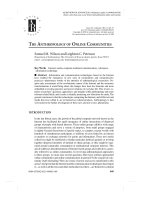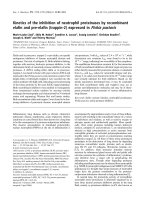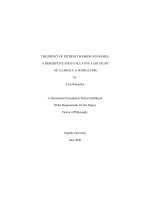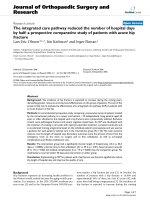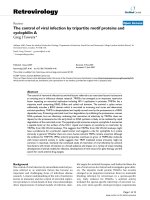The economics of sports 5th by michael a leed and allmen chapter 01
Bạn đang xem bản rút gọn của tài liệu. Xem và tải ngay bản đầy đủ của tài liệu tại đây (430.62 KB, 10 trang )
The Economics of Sports
FIFTH EDITION
Chapter 1
Economics and
Sports
MICHAEL A. LEEDS | PETER VON ALLMEN
The Importance of Sports
• Individuals, cities, and nations can define
themselves in terms of sports
• Sports can be used to achieve diplomatic
goals
• Sports have their own section in the
newspaper
• The sports industry, however, is relatively
small
Copyright ©2014 Pearson Education, Inc. All rights reserved.
1-2
1.1 Text Organization
• The major sections of the book use tools
from three branches of economics
• Part 2 presents the industrial organization of
sports
– Industrial organization addresses issues of firm
behavior
– We will study how firms maximize profits
Copyright ©2014 Pearson Education, Inc. All rights reserved.
1-3
1.1 Text Organization (cont.)
• Part 3 presents the public finance of sports
– Public finance examines what goods the
government should provide and how it should
finance them
• Part 4 covers the labor economics of sports
– Labor economics analyzes employment and
wages
Copyright ©2014 Pearson Education, Inc. All rights reserved.
1-4
1.2 Babe Ruth and Comparative
Advantage
• We use basic economic concepts to explain
the behavior of people, teams, and leagues
• Opportunity cost is a key concept: it is the
value of the best forgone alternative
– We need this concept for comparative advantage
Copyright ©2014 Pearson Education, Inc. All rights reserved.
1-5
Absolute Advantage
• Absolute advantage is the ability to produce
a good or service more efficiently than
anyone else
• Babe Ruth started with the Red Sox
– He was the best pitcher the team had
– He was the best hitter the team had
– Therefore, Babe Ruth had an absolute advantage
in both pitching and hitting
Copyright ©2014 Pearson Education, Inc. All rights reserved.
1-6
Comparative Advantage
• No player, not even Babe Ruth, can be used
as both pitcher and hitter
• The team had to decide in what role Babe
Ruth could be most useful
– Where was he more dominant?
• A person has comparative advantage in an
activity, compared to other persons, if
his/her opportunity cost of that activity is
lower than for other persons
Copyright ©2014 Pearson Education, Inc. All rights reserved.
1-7
Babe Ruth’s Comparative
Advantage
• Babe Ruth had comparative advantage in
hitting
• He was only a little better in pitching than
someone else on the team
• He was much better at hitting that anyone
else on the team
• The Red Sox used him as a hitter
Copyright ©2014 Pearson Education, Inc. All rights reserved.
1-8
Red Sox Benefit
• Babe Ruth was the Red Sox’ best pitcher in
1917 (See Table 1.1)
• He switched to rightfield in 1918
• Both Ruth and the Red Sox benefited
– Red Sox gave up ~10 more runs in 1918 than in
1917 because the replacement pitcher, Dutch
Leonard, was not as good
– But they scored ~29 more runs because Ruth was
better than Tilly Walker, whom he replaced
Copyright ©2014 Pearson Education, Inc. All rights reserved.
1-9
Applying Comparative Advantage
• Moving Ruth to the position where he had
comparative advantage created more runs
for the Red Sox
• Runs create wins, which is the object of the
game
• In general, individuals and nations should
develop and specialize in their comparative
advantage
Copyright ©2014 Pearson Education, Inc. All rights reserved.
1-10
